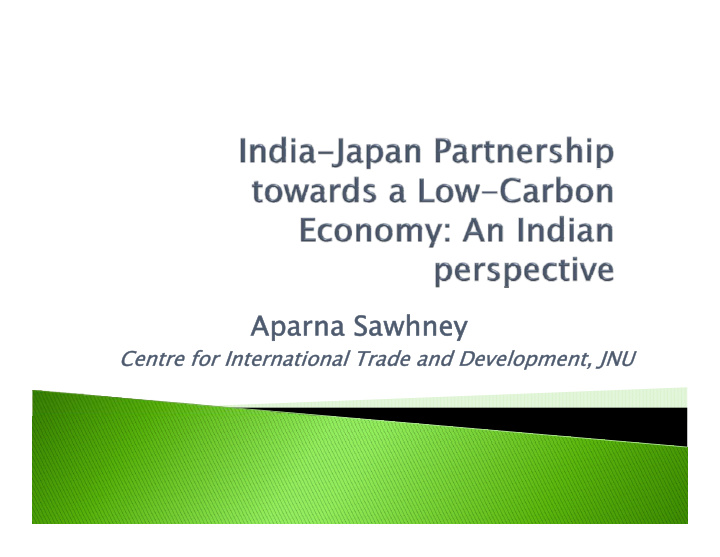



Aparna Aparna Sawhney Sawhney Centre for International Trade and Develop Centre for International Trade and Development, JNU ent, JNU
� Global and national policy focus on low- carbon growth in the run-up to the post- Kyoto negotiations. � The multilateral trade negotiation (Doha � The multilateral trade negotiation (Doha Round) has also turned towards clean/ low- carbon technology trade liberalization in EG carbon technology trade liberalization in EG � Clean energy and associated technology has become most significant in this context
� Energy-related emissions account for an overwhelming 70% of global emissions of h l i 70% f l b l i i f greenhouse gases, due to dominance of conventional fossil fuels in global energy g gy consumption � Imperative for India to balance between high economic growth poverty reduction and economic growth, poverty reduction and carbon emission reduction � Maximum potential for emission reduction in p the growth path is offered by a clean power sector
Thrust on clean energy, and energy efficiency: � Investment incentives for carbon-free power generation (e.g. in wind, solar) in the form of accelerated depreciation, concessional custom duty for specific critical components, excise duty exemption, etc. e e pt o , etc � Other policy support instruments in power generation: feed-in-tariff, renewable portfolio standard t d d
� Vision to lead the world in low-carbon emission revolution. � Become the “Number One Solar Power N ti Nation in the World”. i th W ld” � Domestic focus to enhance demand of solar energy through policy in order to increase energy through policy in order to increase supply capacity and reduce generation cost. � Instruments including subsidy feed-in � Instruments including subsidy, feed in tariff, etc.
� In the global renewable power sector, the fastest growing segment in 2008 was the grid-connected solar photovoltaic. � In solar energy (photovoltaic and � In solar energy (photovoltaic and concentrated solar power for electricity, and solar heating and cooling) the highest current solar heating and cooling) the highest current public R&D expenditures are in the United States, and Italy, Germany, Korea, France, etc.
Target for development and deployment of solar power � Increase solar power capacity to 20,000MW by 2020 by 2020 � Achieve interim grid parity with coal-based thermal power by 2020 and parity by the year thermal power by 2020 and parity by the year 2030
� Obligatory solar power purchase, fiscal investment incentives, subsidies and R&D in investment incentives subsidies and R&D in manufacturing concentrated solar collectors and receivers. � In Special Economic Zone, national and state governments have offered capital investment subsidies of 20% to support solar PV pp manufacturing (solar technology manufacturing parks) � Generation based incentives: proposed at � Generation based incentives: proposed at Rs10/Kwh for the first three years (with reviews in subsequent years)
� Solar PV is the most widespread among different solar technologies in India (also true for global solar market) � Imports in solar PV technology (as embodied � Imports in solar PV technology (as embodied in PV cells/ modules) has been rising steadily. � Significance of source countries have been � Significance of source countries have been changing (imports from Japan however have been relatively small throughout). � Profile of import source nations in recent years:
Shares of Top 7 Countries Shares of Top 7 Countries in Indian in Indian import import of of Solar PV Solar Solar PV Solar PV Technology PV Technology Technology 2003 Technology, , 2003 2003-2009 2003 2009 2009 2009 70 60 60 50 AUSTRALIA SPAIN 40 % share % share U S A GERMANY 30 JAPAN JAPAN TAIWAN 20 CHINA P RP 10 4.22 2.54 2.29 1.85 0.82 0.22 0 0.03 2003 2003 2004 2004 2005 2005 2006 2006 2007 2007 2008 2008 2009 (P) 2009 (P)
� Japan and India have scope for collaborative work as both pursue the goal of making solar energy more cost-effective and commercially viable viable. � In Japan’s current pursuit to emerge again as world leader in solar power, enhancing world leader in solar power, enhancing market demand is key � India has the potential market opportunities, especially given the current targets and supportive policies
� E.g. Japanese companies have the highest number of patent applications for solar energy b f li i f l technology – like, Canon, Sanyo Electric, Sharp, Matsushita Electric, and Kyocera Matsushita Electric, and Kyocera � Large Indian firms engaged in collaboration/ licensing/ joint ventures (e.g. Tata Power with BP Solar in photovoltaic, Moser Baer India Limited in crystalline silicon cell technology and thin-film crystalline silicon cell technology and thin film technology) in order to access technology for solar equipment manufacturing
Recommend
More recommend